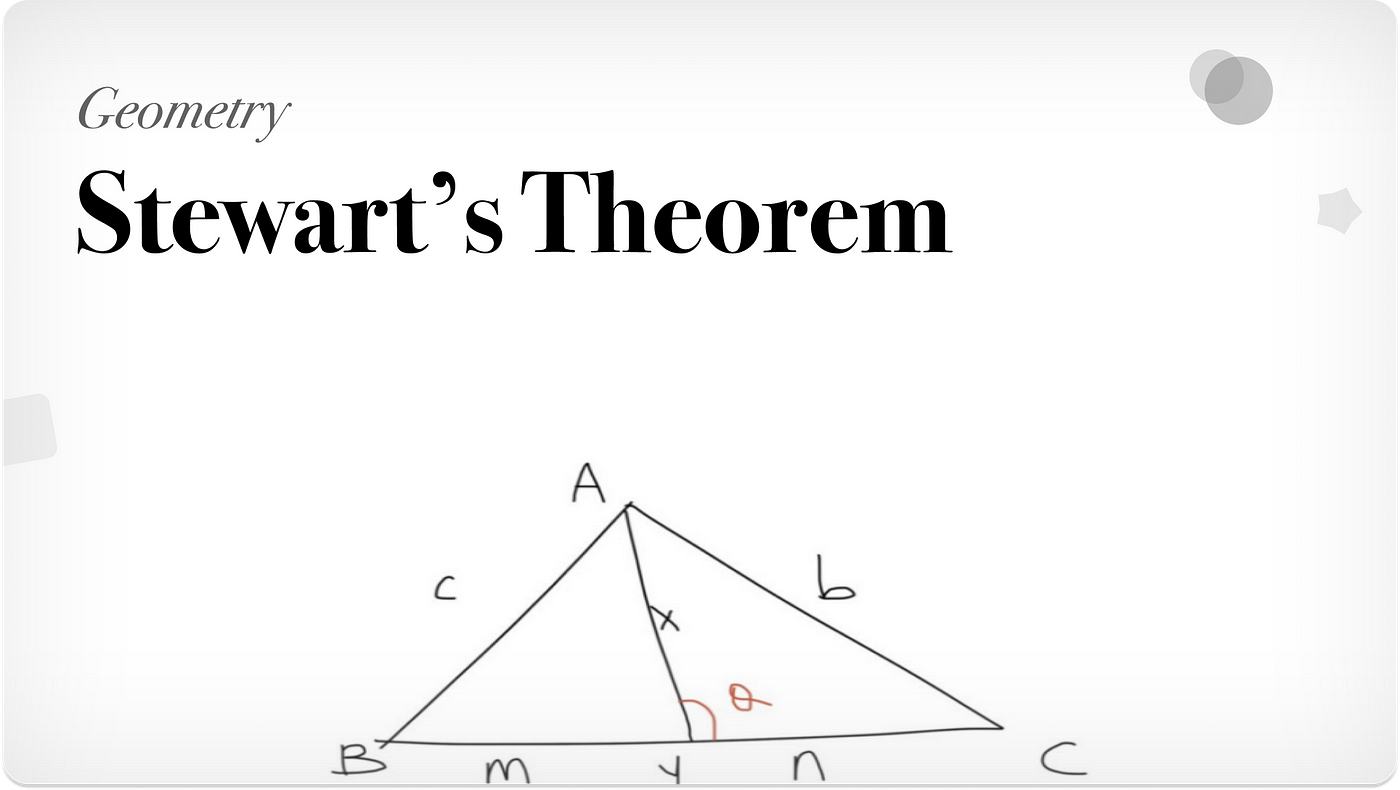
Stewart's Theorem is a fundamental concept in geometry that provides a powerful relationship between the sides and segments of a triangle. Named after the Scottish mathematician Matthew Stewart, this theorem offers valuable insights into the geometric properties of triangles and has wide-ranging applications in various mathematical and scientific fields. Understanding Stewart's Theorem is essential for students and enthusiasts of mathematics, as it forms the basis for solving complex problems related to triangles and their constituent parts.
In this article, we will delve into the intricacies of Stewart's Theorem, exploring its significance, applications, and underlying principles. By uncovering nine essential facts about Stewart's Theorem, we aim to provide a comprehensive understanding of this pivotal concept in geometry. Whether you're a student grappling with geometric theorems or a math enthusiast seeking to expand your knowledge, this exploration of Stewart's Theorem will equip you with valuable insights and practical knowledge that can be applied to a wide array of mathematical challenges.
Key Takeaways:
- Stewart’s Theorem is a cool math concept that helps solve triangle problems by connecting side lengths and cevians. It’s like a secret tool for geometry superheroes!
- Learning Stewart’s Theorem can make you a geometry superhero too! It’s not just for math class, but also for real-world stuff like engineering and architecture. Math is awesome!
Stewart's Theorem is a fundamental concept in geometry.
Stewart's Theorem is a powerful and elegant result in Euclidean geometry that relates the lengths of the segments of a triangle to the length of a cevian, a line segment that extends from a vertex of a triangle to the opposite side. This theorem provides a crucial tool for solving various geometric problems and is widely used in mathematics and its applications.
It is named after the Scottish mathematician Matthew Stewart.
Stewart's Theorem is named after Matthew Stewart, a Scottish mathematician who lived in the 18th century. Stewart made significant contributions to mathematics, and this theorem stands as a testament to his intellectual legacy.
The theorem provides a relationship between the side lengths and a cevian of a triangle.
Stewart's Theorem establishes a connection between the side lengths of a triangle and the length of a cevian, offering a valuable insight into the geometric properties of triangles and their associated line segments.
It can be used to solve various problems in geometry.
Stewart's Theorem serves as a powerful tool for solving a wide range of geometric problems, including those related to triangles, cevians, and their associated lengths. Its versatility and applicability make it an indispensable asset in the mathematician's toolkit.
The theorem is often used in trigonometry and calculus.
Stewart's Theorem finds applications in advanced mathematical fields such as trigonometry and calculus, where its principles are leveraged to tackle complex problems and derive meaningful results.
It is a key concept in high school geometry curriculum.
Stewart's Theorem holds a significant place in the high school geometry curriculum, where students learn about its principles and applications in solving geometric problems and understanding the intricacies of triangles and cevians.
The theorem has practical applications in fields such as engineering and architecture.
Beyond its theoretical significance, Stewart's Theorem finds practical applications in real-world disciplines such as engineering and architecture, where geometric principles play a crucial role in design, analysis, and problem-solving.
Understanding Stewart's Theorem can enhance problem-solving skills in mathematics.
Mastery of Stewart's Theorem equips students and mathematicians with enhanced problem-solving skills, enabling them to approach geometric challenges with a deeper understanding of the relationships between triangle side lengths and cevians.
Stewart's Theorem exemplifies the beauty and utility of mathematical principles.
Stewart's Theorem stands as a testament to the beauty and utility of mathematical principles, showcasing the elegance and power of geometric theorems in unraveling the mysteries of shape, space, and structure.
Stewart's Theorem, named after the Scottish mathematician Matthew Stewart, is a fundamental concept in geometry that provides a powerful relationship between the side lengths of a triangle and the length of a cevian. This elegant theorem is a key tool for solving various geometric problems and finds applications in fields such as trigonometry, calculus, engineering, and architecture. By mastering Stewart's Theorem, students and mathematicians can enhance their problem-solving skills and gain a deeper appreciation for the beauty and utility of mathematical principles.
Conclusion
In conclusion, Stewart's Theorem is a powerful and versatile tool in the field of mathematics, offering a unique approach to solving problems related to triangles. By understanding the fundamental principles behind this theorem and its applications, mathematicians and students alike can gain valuable insights into the relationships between sides and segments within a triangle. The theorem's ability to provide solutions for a wide range of geometric scenarios underscores its significance in both theoretical and practical contexts. As we continue to explore the depths of mathematical sciences, Stewart's Theorem stands as a testament to the enduring relevance and ingenuity of mathematical principles.
FAQs
What is Stewart's Theorem?
Stewart's Theorem is a fundamental result in geometry that establishes a relationship between the side lengths and segments of a triangle, providing a means to solve for unknown values within the triangle.
How is Stewart's Theorem applied in mathematics?
Stewart's Theorem is applied to various geometric problems involving triangles, such as determining the length of a cevian (a line segment within a triangle) or solving for unknown side lengths based on given information about the triangle's sides and segments.
Was this page helpful?
Our commitment to delivering trustworthy and engaging content is at the heart of what we do. Each fact on our site is contributed by real users like you, bringing a wealth of diverse insights and information. To ensure the highest standards of accuracy and reliability, our dedicated editors meticulously review each submission. This process guarantees that the facts we share are not only fascinating but also credible. Trust in our commitment to quality and authenticity as you explore and learn with us.
